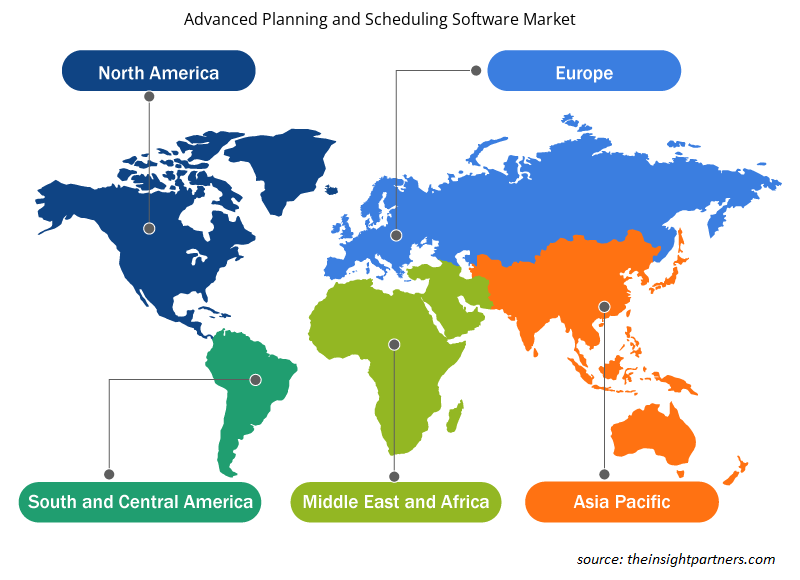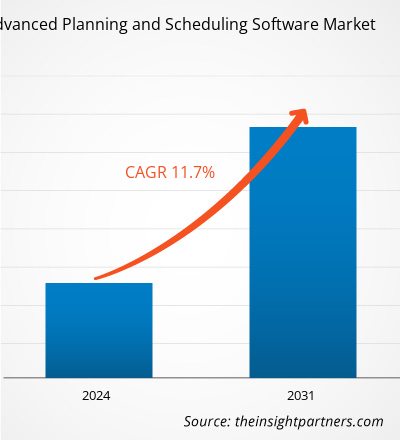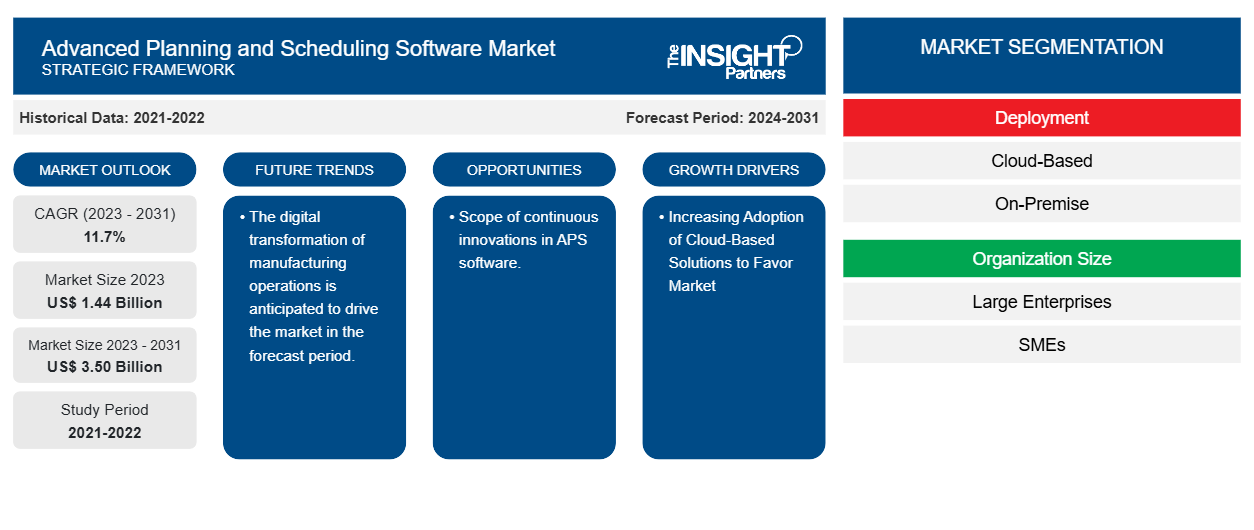Der Markt für fortschrittliche Planungs- und Terminierungssoftware soll von 1,44 Milliarden US-Dollar im Jahr 2023 auf 3,50 Milliarden US-Dollar im Jahr 2031 anwachsen. Der Markt wird zwischen 2023 und 2031 voraussichtlich eine durchschnittliche jährliche Wachstumsrate (CAGR) von 11,7 % verzeichnen. Der zunehmende Bedarf zur Verbesserung des gesamten Produktionsprozesses und die zunehmende Einführung cloudbasierter Lösungen dürften weiterhin wichtige Trends und Treiber des Marktes bleiben.
Marktanalyse für erweiterte Planungs- und Terminierungssoftware
Der Markt für fortschrittliche Planungs- und Terminierungssoftware verzeichnet weltweit ein deutliches Wachstum. Dieses Wachstum ist auf den zunehmenden Bedarf an der Verbesserung des gesamten Produktionsprozesses und die zunehmende Einführung cloudbasierter Lösungen zurückzuführen. Darüber hinaus wird erwartet, dass der zunehmende Spielraum für kontinuierliche Innovationen bei APS-Software und die digitale Transformation von Fertigungsabläufen in den kommenden Jahren mehrere Chancen für den Markt bietet.
Marktübersicht für erweiterte Planungs- und Terminierungssoftware
Advanced Planning and Scheduling (APS) ist eine Lösung, die Herstellern hilft, ihre Produktionsplanung und Werkstattplanung zu steuern. Durch die Nutzung fortschrittlicher Algorithmen zum Ausgleich von Nachfrage und Kapazität und zur Erstellung realisierbarer Produktionspläne führt die Software für Advanced Planning and Scheduling zu schnelleren Vorlaufzeiten zur Erfüllung der Kundennachfrage und einfacheren, schnelleren Reaktionen auf unerwartete Produktionsänderungen.
Passen Sie diesen Bericht Ihren Anforderungen an
Sie erhalten kostenlose Anpassungen an jedem Bericht, einschließlich Teilen dieses Berichts oder einer Analyse auf Länderebene, eines Excel-Datenpakets sowie tolle Angebote und Rabatte für Start-ups und Universitäten.
-
Holen Sie sich die wichtigsten Markttrends aus diesem Bericht.Dieses KOSTENLOSE Beispiel umfasst eine Datenanalyse von Markttrends bis hin zu Schätzungen und Prognosen.
Treiber und Chancen auf dem Markt für erweiterte Planungs- und Terminierungssoftware
Zunehmende Nutzung Cloud-basierter Lösungen begünstigt den Markt.
Die zunehmende Nutzung von Cloud-basierten Lösungen treibt tatsächlich das Wachstum des Marktes für fortschrittliche Planungs- und Terminierungssoftware voran. Das Cloud-basierte System für fortschrittliche Planung und Terminierung (CAPS) basiert auf intelligenter dynamischer Planung und Terminierung (IDPS), die aus fünf Hauptmodulen besteht, darunter Eingabe, Simulation, Kapazitätsplanung (CP), Kapazitätsauswirkungsanalyse (CIA) und Ausgabe. Darüber hinaus erfordern Cloud-basierte APS-Lösungen im Vergleich zu den On-Premise-Lösungen geringe Direktinvestitionen. Dies erhöht die Nachfrage nach fortschrittlicher Planungs- und Terminierungssoftware für Unternehmen, einschließlich KMU. Unter Berücksichtigung der oben genannten Parameter treibt die zunehmende Nutzung von Cloud-basierten Lösungen das Wachstum des Marktes für fortschrittliche Planungs- und Terminierungssoftware voran.
Umfang kontinuierlicher Innovationen in der APS-Software.
Der Umfang kontinuierlicher Innovationen bei APS-Software bietet dem Markt erhebliche Chancen. Kontinuierliche Innovationen können zu adaptiven Algorithmen und zur Integration von Funktionen in Systeme wie ERP , MES und IoT-Geräte führen. Außerdem verbessert es die Benutzerfreundlichkeit intuitiver Schnittstellen, indem es benutzerfreundlicher wird, die Lernkurve verkürzt und die Akzeptanz bei nicht-technischen Benutzern erhöht. APS-Software bietet außerdem Vorteile wie Anpassung und Flexibilität, prädiktive Analysen, maschinelles Lernen, Cloud-basierte Lösungen und mobilen Zugriff. Unter Berücksichtigung der oben genannten Faktoren wird erwartet, dass der Umfang kontinuierlicher Innovationen bei APS-Software den Markt für fortschrittliche Planungs- und Terminierungssoftware vorantreiben wird.
Segmentierungsanalyse des Marktberichts für erweiterte Planungs- und Terminierungssoftware
Wichtige Segmente, die zur Ableitung der Marktanalyse für erweiterte Planungs- und Terminierungssoftware beigetragen haben, sind Einsatz, Organisationsgröße und Branche.
- Basierend auf der Bereitstellung wird der Markt für erweiterte Planungs- und Terminierungssoftware in Cloud-basierte und On-Premise-Software unterteilt. Das Segment der Energiemanagementkomponenten wird im Prognosezeitraum voraussichtlich einen erheblichen Marktanteil halten.
- Basierend auf der Unternehmensgröße ist der Markt für erweiterte Planungs- und Terminierungssoftware in Großunternehmen und KMU unterteilt. Das Segment der Großunternehmen dürfte im Prognosezeitraum einen erheblichen Marktanteil halten.
- Nach Branchen ist der Markt segmentiert in Fertigung, Pharmazeutika und Biowissenschaften, Einzelhandel und Konsumgüter, Lebensmittel und Getränke, Chemie, Automobil, Luft- und Raumfahrt und Verteidigung, Elektronik und andere. Es wird erwartet, dass die Fertigung im Prognosezeitraum einen erheblichen Marktanteil halten wird.
Marktanteilsanalyse für erweiterte Planungs- und Terminierungssoftware nach geografischer Lage
Der geografische Umfang des Marktberichts für erweiterte Planungs- und Terminierungssoftware ist hauptsächlich in fünf Regionen unterteilt: Nordamerika, Asien-Pazifik, Europa, Naher Osten und Afrika sowie Süd- und Mittelamerika.
Nordamerika dominiert den Markt für fortschrittliche Planungs- und Terminierungssoftware. Der nordamerikanische Markt ist in die USA, Kanada und Mexiko unterteilt. Die Trends zur Einführung hoher Technologien in verschiedenen Branchen in der nordamerikanischen Region haben das Wachstum des Marktes für fortschrittliche Planungs- und Terminierungssoftware vorangetrieben. Faktoren wie die zunehmende Implementierung digitaler Tools und hohe Technologieausgaben von Regierungsbehörden dürften das Wachstum des nordamerikanischen Marktes für fortschrittliche Planungs- und Terminierungssoftware vorantreiben. Darüber hinaus zwingt eine starke Betonung von Forschung und Entwicklung in den entwickelten Volkswirtschaften der USA und Kanadas die nordamerikanischen Akteure dazu, technologisch fortschrittliche Lösungen auf den Markt zu bringen. Darüber hinaus gibt es in den USA eine große Anzahl von Akteuren auf dem Markt für fortschrittliche Planungs- und Terminierungssoftware, die sich zunehmend auf die Entwicklung innovativer Lösungen konzentrieren. All diese Faktoren tragen zum Wachstum des Marktes für fortschrittliche Planungs- und Terminierungssoftware in der Region bei.
Regionale Einblicke in den Markt für erweiterte Planungs- und Terminierungssoftware
Die regionalen Trends und Faktoren, die den Markt für Advanced Planning and Scheduling Software während des gesamten Prognosezeitraums beeinflussen, wurden von den Analysten von Insight Partners ausführlich erläutert. In diesem Abschnitt werden auch Marktsegmente und Geografien für Advanced Planning and Scheduling Software in Nordamerika, Europa, im asiatisch-pazifischen Raum, im Nahen Osten und Afrika sowie in Süd- und Mittelamerika erörtert.

- Erhalten Sie regionale Daten zum Markt für erweiterte Planungs- und Terminplanungssoftware
Umfang des Marktberichts zu erweiterter Planungs- und Terminierungssoftware
| Berichtsattribut | Details |
|---|---|
| Marktgröße im Jahr 2023 | 1,44 Milliarden US-Dollar |
| Marktgröße bis 2031 | 3,50 Milliarden US-Dollar |
| Globale CAGR (2023 - 2031) | 11,7 % |
| Historische Daten | 2021-2022 |
| Prognosezeitraum | 2024–2031 |
| Abgedeckte Segmente |
Nach Bereitstellung
|
| Abgedeckte Regionen und Länder |
Nordamerika
|
| Marktführer und wichtige Unternehmensprofile |
|
Dichte der Marktteilnehmer für erweiterte Planungs- und Terminierungssoftware: Die Auswirkungen auf die Geschäftsdynamik verstehen
Der Markt für erweiterte Planungs- und Terminierungssoftware wächst rasant. Dies wird durch die steigende Nachfrage der Endnutzer aufgrund von Faktoren wie sich entwickelnden Verbraucherpräferenzen, technologischen Fortschritten und einem größeren Bewusstsein für die Vorteile des Produkts vorangetrieben. Mit der steigenden Nachfrage erweitern Unternehmen ihr Angebot, entwickeln Innovationen, um die Bedürfnisse der Verbraucher zu erfüllen, und nutzen neue Trends, was das Marktwachstum weiter ankurbelt.
Die Marktteilnehmerdichte bezieht sich auf die Verteilung der Firmen oder Unternehmen, die in einem bestimmten Markt oder einer bestimmten Branche tätig sind. Sie gibt an, wie viele Wettbewerber (Marktteilnehmer) in einem bestimmten Marktraum im Verhältnis zu seiner Größe oder seinem gesamten Marktwert präsent sind.
Die wichtigsten Unternehmen auf dem Markt für erweiterte Planungs- und Terminierungssoftware sind:
- ACUMATICA, INC
- ASPROVA CORPORATION
- Cybertec
- Dassault Systemes SE
- DELFOI OY
- GLOBALE SHOP-LÖSUNGEN
Haftungsausschluss : Die oben aufgeführten Unternehmen sind nicht in einer bestimmten Reihenfolge aufgeführt.

- Erhalten Sie einen Überblick über die wichtigsten Akteure auf dem Markt für erweiterte Planungs- und Terminierungssoftware
Marktnachrichten und aktuelle Entwicklungen zu erweiterter Planungs- und Terminierungssoftware
Der Markt für fortschrittliche Planungs- und Terminierungssoftware wird durch die Erfassung qualitativer und quantitativer Daten nach Primär- und Sekundärforschung bewertet, die wichtige Unternehmensveröffentlichungen, Verbandsdaten und Datenbanken umfasst. Nachfolgend sind einige der Entwicklungen auf dem Markt für fortschrittliche Planungs- und Terminierungssoftware aufgeführt:
- Cosmo Tech hat eine spezielle APS-Konnektorbibliothek für fortschrittliche Planungs- und Terminierungssoftware eingeführt. Die Cosmo Tech APS Connector Library bietet mehrere vorgefertigte Konnektoren und die Möglichkeit zur Integration mit beliebten Supply-Chain-Planungslösungen wie SAP IBP, Blue Yonder, Kinaxis und OMP. (Quelle: Cosmo Tech Company Website, Juni 2024)
- Amtech Software mit Sitz in Fort Washington, Pennsylvania, kündigte die Einführung von Advanced Planning Board (APB) an, der neuesten Innovation, die sich nahtlos in Encore ERP integrieren lässt. APB ist eine webbasierte Lösung, die einen flexiblen Punktealgorithmus zur Automatisierung der Planungsfunktion verwendet, sodass die Anlagenplaner problemlos Artikel mit mehreren Durchgängen und mehreren Teilen handhaben können. (Quelle: Amtech Software, Unternehmenswebsite, April 2024)
Marktbericht zu erweiterter Planungs- und Terminierungssoftware – Umfang und Ergebnisse
Der Bericht „Marktgröße und Prognose für erweiterte Planungs- und Terminplanungssoftware (2021–2031)“ bietet eine detaillierte Analyse des Marktes, die die folgenden Bereiche abdeckt:
- Marktgröße und Prognose für erweiterte Planungs- und Terminierungssoftware auf globaler, regionaler und Länderebene für alle abgedeckten wichtigen Marktsegmente.
- Markttrends für erweiterte Planungs- und Terminierungssoftware sowie Marktdynamik wie treibende Faktoren, Einschränkungen und wichtige Chancen.
- Detaillierte PEST/Porters Five Forces- und SWOT-Analyse.
- Marktanalyse für erweiterte Planungs- und Terminierungssoftware, die wichtige Markttrends, globale und regionale Rahmenbedingungen, wichtige Akteure, Vorschriften und aktuelle Marktentwicklungen umfasst.
- Branchenlandschaft und Wettbewerbsanalyse, einschließlich Marktkonzentration, Heatmap-Analyse, prominenten Akteuren und aktuellen Entwicklungen für den Markt für erweiterte Planungs- und Terminierungssoftware.
- Detaillierte Firmenprofile.
- Historische Analyse (2 Jahre), Basisjahr, Prognose (7 Jahre) mit CAGR
- PEST- und SWOT-Analyse
- Marktgröße Wert/Volumen – Global, Regional, Land
- Branchen- und Wettbewerbslandschaft
- Excel-Datensatz
Aktuelle Berichte
Verwandte Berichte
Erfahrungsberichte
Grund zum Kauf
- Fundierte Entscheidungsfindung
- Marktdynamik verstehen
- Wettbewerbsanalyse
- Kundeneinblicke
- Marktprognosen
- Risikominimierung
- Strategische Planung
- Investitionsbegründung
- Identifizierung neuer Märkte
- Verbesserung von Marketingstrategien
- Steigerung der Betriebseffizienz
- Anpassung an regulatorische Trends























 Kostenlose Probe anfordern für - Markt für erweiterte Planungs- und Terminplanungssoftware
Kostenlose Probe anfordern für - Markt für erweiterte Planungs- und Terminplanungssoftware